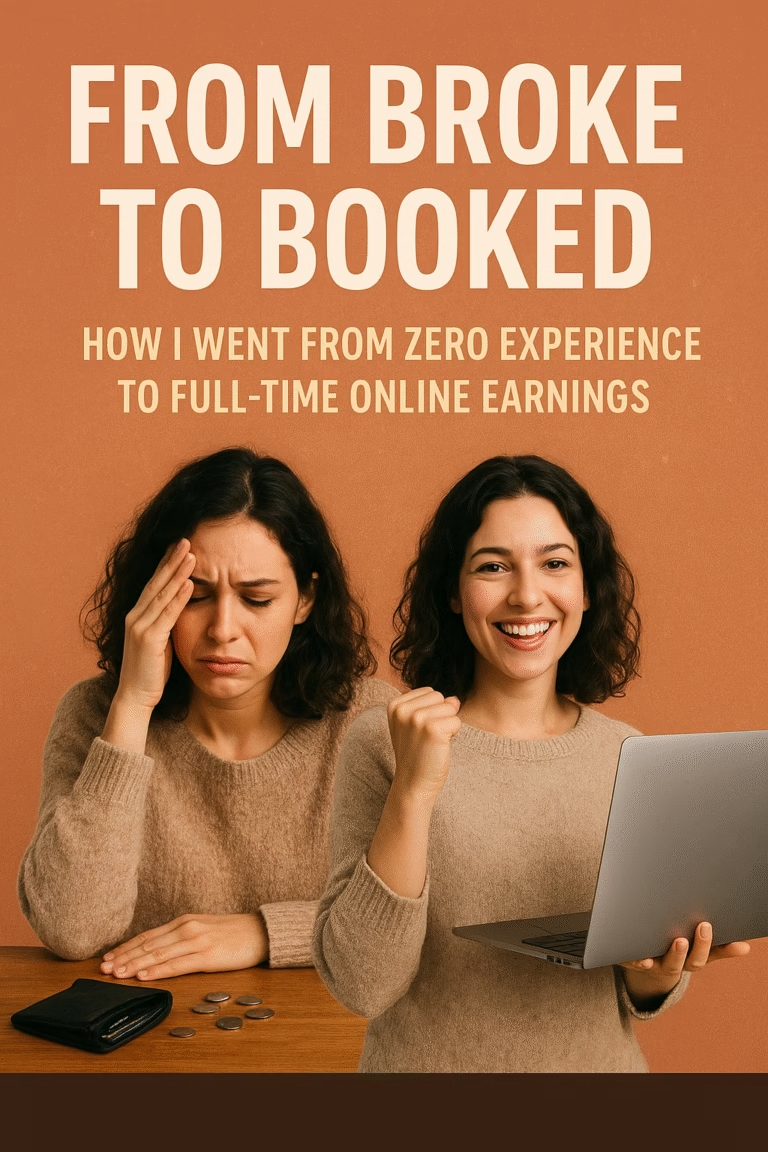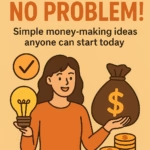How I Went From Zero Experience to Full-Time Online Earnings
The brutally honest story of how I transformed my financial life—and how you can too
The Rock Bottom Moment
It was 2:47 AM on a Tuesday when I checked my bank account: $14.23. My rent was due in three days, and I had just eaten instant ramen for the fifth night in a row—not by choice, but by necessity.
I remember sitting in my dimly lit apartment, the glow of my laptop screen illuminating the anxiety on my face. I had a college degree, years of “experience,” and absolutely nothing to show for it. The traditional path had failed me spectacularly.
That night, I made a decision that would change everything. I decided to stop doing what wasn’t working and start building something of my own online.
This is the unfiltered story of how I went from broke and desperate to earning a full-time income online—with zero prior experience in digital business.
The Harsh Reality Check (Month 0-2)
Let me be clear: the first two months were terrible. Anyone who tells you making money online is easy is either lying or selling you something.
Here’s what my early days actually looked like:
My Failed Attempts:
- Lost $300 on a “guaranteed” dropshipping course
- Spent 60 hours building a blog that got 12 total visitors (3 were my mom)
- Applied to 47 freelance jobs and got 2 responses (both rejections)
- Tried affiliate marketing and made exactly $0.00
I was exhausted, discouraged, and seriously questioning whether any of this was real or just an elaborate internet fantasy.
But here’s what I learned during those brutal first months: every failure was teaching me something crucial about what actually works online.
The Turning Point: Finding My First $100
Eventually, I found a few freelance jobs that helped me gain confidence and experience in the field of online work.
Everything shifted when I stopped chasing “passive income” fantasies and focused on one simple question: What valuable skill can I offer right now?
For me, that skill was writing. I’d always been decent at putting words together, but I never thought of it as a “real” marketable skill. I was wrong.
My First Real Strategy
I created profiles on three platforms:
- Upwork – For professional freelance gigs
- Fiverr – For quick, accessible services
- Medium – To build a portfolio and credibility
By exploring various online jobs, I discovered opportunities that aligned with my skills and interests.
Instead of applying to every job, I got strategic:
- I identified 10 specific niches I could write about (fitness, productivity, personal finance)
- I created 5 portfolio samples (even though no one paid me for them)
- I personalized every single proposal with specific value I could add
- I started my rates embarrassingly low ($25 per article) just to build momentum
Week 3 of this strategy: I landed my first paid client. $75 for a 1,500-word article about meal planning. I spent 6 hours on it and earned $12.50/hour, but I felt like I’d won the lottery.
That first $75 proved something crucial: people will pay for value, even from beginners.
Months 3-6: The Hustle Phase
This period was about volume and learning. I said yes to (almost) everything, even when I wasn’t sure I could deliver. Here’s the progression:
| Month | Projects | Revenue | Hourly Rate | Key Lesson |
|---|---|---|---|---|
| 3 | 8 articles | $420 | ~$15/hr | Speed matters; create templates |
| 4 | 12 articles | $780 | ~$22/hr | Niching down increases rates |
| 5 | 15 articles + 2 big clients | $1,340 | ~$28/hr | Regular clients = stability |
| 6 | 18 projects | $2,100 | ~$35/hr | Raise your rates every month |
The Three Rules I Lived By
Rule 1: Overdeliver on everything
I didn’t just write articles—I researched keywords, suggested headlines, included relevant stats, and delivered early. This turned one-time clients into repeat customers.
Rule 2: Ask for testimonials immediately
After every successful project, I’d say: “I’m building my portfolio—would you mind writing a quick sentence about working with me?” These testimonials became my secret weapon for landing better clients.
Rule 3: Invest back into learning
I spent 10% of everything I earned on courses, books, and tools. I took a $50 course on SEO writing that directly led to a $500/month retainer client.
Months 7-9: The Scaling Breakthrough
By month 7, something clicked. I wasn’t just a freelancer anymore—I was running a small business.
What Changed
I stopped trading time for money directly. Instead of pricing per hour, I started pricing per project based on value. A website homepage that took me 3 hours? That’s $500 because it would drive conversions for their business.
I created systems. I built:
- Email templates for client communication
- Project management workflows in Trello
- Content templates for common article types
- An onboarding process that made clients feel valued
I doubled my rates. Seriously. I just… asked for twice as much. And shockingly, most clients said yes. The ones who said no weren’t my ideal clients anyway.
I started saying no. This was the hardest lesson. I turned down projects that didn’t pay well, didn’t align with my values, or came from nightmare clients. Each “no” created space for better opportunities.
By month 9, I was earning $3,800—more than I’d ever made in any traditional job.
Months 10-12: Building Multiple Income Streams
Once I had one reliable income stream, I diversified:
Income Stream Breakdown (Month 12)
| Income Source | Monthly Earnings | Time Investment | Sustainability |
|---|---|---|---|
| Retainer clients (3) | $3,500 | 50 hours | High |
| One-off projects | $1,200 | 15 hours | Medium |
| Affiliate marketing | $480 | 5 hours | Growing |
| Digital product (writing templates) | $220 | 2 hours | Passive |
| TOTAL | $5,400 | 72 hours | Strong |
Creating My First Digital Product
This was my introduction to “making money while I sleep.” I created a $29 package of article templates and outlines for new freelance writers. It took me one weekend to create and has earned over $4,000 since launch with minimal maintenance.
The key wasn’t the product itself—it was that I’d built an audience (email list and social media followers) who trusted my advice because I’d been helping them for free for months.
Year Two: Going Full-Time
In month 13, I quit my part-time retail job. My hands were shaking as I turned in my resignation, but the numbers didn’t lie—I was earning double from my online work.
Current Income Reality (Month 18)
- Average monthly income: $7,200-$8,500
- Client roster: 4 retainer clients + selective project work
- Digital products: 3 templates/courses earning $800-1,200/month
- Email list: 3,400 subscribers
- Work hours: 30-35 hours per week (genuine flexibility)
But more than the money, what changed was my relationship with work. I decide when I work, who I work with, and what projects I take on. I took a three-week trip to Portugal last summer and worked from cafes overlooking the ocean.
This isn’t a humble brag—it’s proof that this path is accessible to normal people.
The Brutal Truths Nobody Tells You
It’s Not Actually Passive (At First)
Those first 12 months? I worked harder than I’ve ever worked. Nights, weekends, every spare moment. “Passive income” required intensely active effort to build.
You’ll Feel Like a Fraud
Imposter syndrome is real. I still sometimes can’t believe people pay me for my words. But here’s the secret: everyone feels this way. Your clients don’t need you to be the world’s expert—they need you to be two steps ahead of them.
Most People Will Think You’re Crazy
My family thought I was having a quarter-life crisis. Friends made jokes about my “little internet hobby.” Traditional career advisors told me I was throwing away my degree.
Tune them out. They’re operating from a 20th-century playbook.
The Money Isn’t Consistent (Until It Is)
Some months I earned $2,000. Some months I earned $6,000. This volatility is terrifying at first, but it smooths out as you build retainer clients and diversified income streams.
You Have to Treat It Like a Real Business
The people who fail at making money online are treating it like a side hustle or hobby. I created invoices, tracked expenses, paid quarterly taxes, and set business hours. Professionalism = sustainability.
The Exact Blueprint: How You Can Do This Too
Phase 1: Foundation (Months 1-3)
Step 1: Identify your marketable skill
- What can you do better than average? (Writing, design, video editing, social media, virtual assistance, coding, teaching, bookkeeping)
- Don’t have a skill? Pick one and spend 30 days learning it intensively
Step 2: Create your online presence
- Build profiles on Upwork, Fiverr, or Freelancer
- Create a simple portfolio website (use Wix, WordPress, or Carrd—spend under $50)
- Start a LinkedIn and optimize it for your niche
Step 3: Create 3-5 portfolio samples
- Yes, work for free initially—for yourself
- These samples prove you can deliver value
Step 4: Apply, apply, apply
- Customize every proposal
- Start with competitive (low) rates to build reviews
- Aim for 10-15 applications per day
Goal: Land your first 3 paid clients, even if rates are low
Phase 2: Growth (Months 4-8)
Step 1: Overdeliver and ask for testimonials
Step 2: Raise your rates by 20-30% every 6 weeks
Step 3: Focus on one specific niche
- Instead of “I’m a writer,” become “I write conversion-focused website copy for fitness coaches”
Step 4: Build relationships, not transactions
- Check in with past clients monthly
- Offer value without expecting payment
- Ask for referrals
Step 5: Start building an audience
- Email list (use Mailchimp or ConvertKit free tiers)
- Social media presence (LinkedIn, Twitter/X, or Instagram)
- Share valuable content consistently
Goal: Hit $2,000-3,000/month and establish 1-2 retainer clients
Phase 3: Scale (Months 9-12)
Step 1: Create systems for everything
- Templates for common deliverables
- Automated onboarding processes
- Scheduling tools for calls
Step 2: Launch your first digital product
- Course, template, ebook, or toolkit
- Price it between $27-97
- Sell to your email list
Step 3: Continue raising rates and being selective
Step 4: Consider outsourcing tasks you don’t enjoy
- Virtual assistant for admin work
- Subcontractor for overflow work
Goal: Hit $4,000-5,000/month with diversified income streams
Resources That Actually Helped Me
Essential Tools (All Free or Low-Cost Options Available)
For freelancing:
- Upwork – Largest freelance marketplace
- Fiverr – Quick gigs and building reputation
- Contra – Commission-free freelancing
For learning:
- Coursera – Professional courses (many free)
- HubSpot Academy – Free marketing certifications
- YouTube (seriously—thousands of hours of free expertise)
For productivity:
- Notion – Free project management
- Google Workspace – Professional email and docs
- Calendly – Free scheduling tool
For building audience:
- Mailchimp – Free for first 500 subscribers
- Canva – Free design tool for social media
- Buffer – Free social media scheduling
Books That Changed My Thinking
- “The $100 Startup” by Chris Guillebeau
- “Company of One” by Paul Jarvis
- “Show Your Work” by Austin Kleon
The Questions I Get Most Often
Q: How much money do I need to start?
Honestly? I started with $0. Created free accounts, used free trials, and built from there. If you have $50-100, you can create a more professional setup faster, but it’s not required.
Q: How long until I can quit my job?
Most people need 6-12 months to build income that matches a full-time salary. Don’t quit your job on day one. Build this as a side project until the numbers prove themselves.
Q: What if I don’t have any skills?
Everyone has skills—you just haven’t packaged them yet. Can you organize things? Virtual assistance. Can you talk to people? Customer service or sales. Are you good at social media? Social media management. Start with what you know, then learn what you need.
Q: Is this sustainable long-term?
The freelance economy is growing exponentially. According to recent studies, over 50% of U.S. workers are expected to freelance by 2027. This isn’t a fad—it’s the future of work.
Q: What about taxes and legal stuff?
Track all income and expenses from day one. Set aside 25-30% of earnings for taxes. In the U.S., register as an LLC once you’re earning $2,000+/month. Consult with an accountant (worth every penny).
The Real Cost and The Real Reward
What I Sacrificed
- Social life for 8 months (I became really boring at parties)
- Security and predictability
- The comfort of “normal”
- Weekend lie-ins (early months were 7-day work weeks)
- About $500 in failed experiments and bad courses
What I Gained
- Financial independence (no more asking permission for time off)
- Time freedom (I work 30 hours weekly now, not 50+)
- Location independence (worked from 8 countries last year)
- Confidence in my abilities
- Control over my income ceiling
- The satisfaction of building something that’s mine
The exchange was worth it one thousand times over.
Final Thoughts: You Can Absolutely Do This
If you’d told me three years ago that I’d be earning a full-time income online, working from anywhere, and genuinely enjoying my work, I would have laughed in your face.
I wasn’t special. I didn’t have secret connections, a trust fund, or exceptional talent. I was broke, scared, and completely clueless about online business.
What I did have was:
- Willingness to learn
- Consistency even when it sucked
- Enough desperation to push through discomfort
- Faith that if others could do it, so could I
The internet has democratized opportunity in an unprecedented way. Anyone with WiFi access can build something valuable and get paid for it. The tools are free or cheap. The information is available. The clients are out there looking for someone exactly like you.
The only question is: are you willing to start?
Not next month. Not when you’re “ready.” Not after one more course.
Today. Right now. With what you have.
Because three years from now, you’ll either wish you’d started today, or you’ll be incredibly grateful that you did.
Your Turn: Take Action Right Now
If this article resonated with you, here’s your homework:
Today:
- Identify one skill you can monetize
- Create a profile on one freelance platform
- Write down your “why”—the real reason you want to change your financial situation
This week:
- Create 1-2 portfolio samples
- Apply to 5 relevant jobs/gigs
- Follow 10 people in your chosen industry on social media
This month:
- Apply to 50+ opportunities
- Land your first paid project
- Start building an email list (even if it’s just 10 people)
The journey from broke to thriving doesn’t happen overnight. But it absolutely happens. One client, one project, one small win at a time.
I believe in you. Now it’s time for you to believe in you too.
What’s your biggest obstacle to starting your online income journey? Drop a comment below—I read and respond to every one.
Ready to dive deeper? Subscribe to my newsletter where I share weekly strategies, real income reports, and lessons learned from building multiple online income streams.



